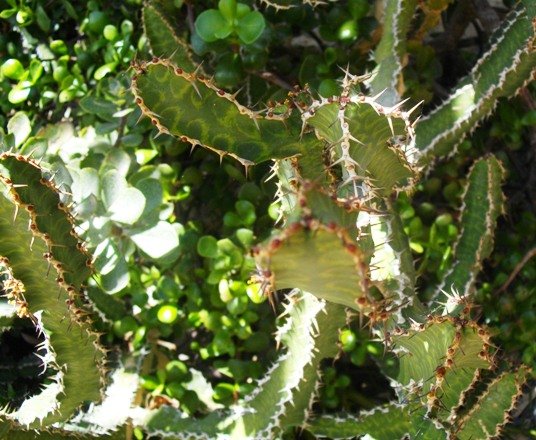Euphorbia pseudocactus

Author: Ivan Lätti
Photographer: Ivan Lätti
Euphorbia pseudocactus, the Natal noors (Natal spurge) or candelabra spurge, is a spiny, multi-branched shrub that grows taller than 1 m and spreads to 2 m, often forming large stands that may dominate.
The central, main stem is often largely invisible, much of it underground. The mostly erect, lowly branched stems have irregular mottling in shades of green: Between the three to five stem ribs these partly dark green surfaces are intriguingly marked with whitish, V-shaped embellishments. The stems also have spaced constrictions into segments that bulge, reminding of E. cooperi. The spine shields connect in horny ridges, ageing to whitish grey. The spines are grey brown, later whitish, paired, fierce and regularly angled, about 1 cm long. Small leaves appear briefly at the top in the growing season.
The small, cup-shaped cyathia grow in horizontal, yellow cymes of up to three if not solitary on upper stem ridges. The central one is male, the lateral ones bisexual. The glands often curved outwards.
The species distribution is restricted to the Muden Valley in central KwaZulu-Natal.
The habitat is hot, dry thicket in rocky areas. The species is not considered threatened in habitat early in the twenty first century.
The colloquial name candelabra spurge suggests the appearance of a candelabra and a cactus, the former a descriptive likeness, the second superficially the same, but really a misidentification as euphorbia and cactus are quite different genera.
South African plants are sometimes given interesting additional common names when they spread beyond the border (emigrate?). This one has received the remarkable name of urban cowboy in the USA. If that is deserved, it would be good to learn what caused the choice of such a name.
Locally many euphorbias are called spurges. The spurge name is apparently derived from some ill-advised experimental medicine of the Middle Ages when the noxious latex of some euphorbias had been ingested by patients. Spurge came from purge! The ghastly effects can be imagined (Frandsen, 2017; Smith, et al, 2017; Pooley, 1998; www.cactus-art.biz; www.plantsarethestrangestpeople.blogspot.com; www.plantzafrica.com; http://redlist.sanbi.org).

